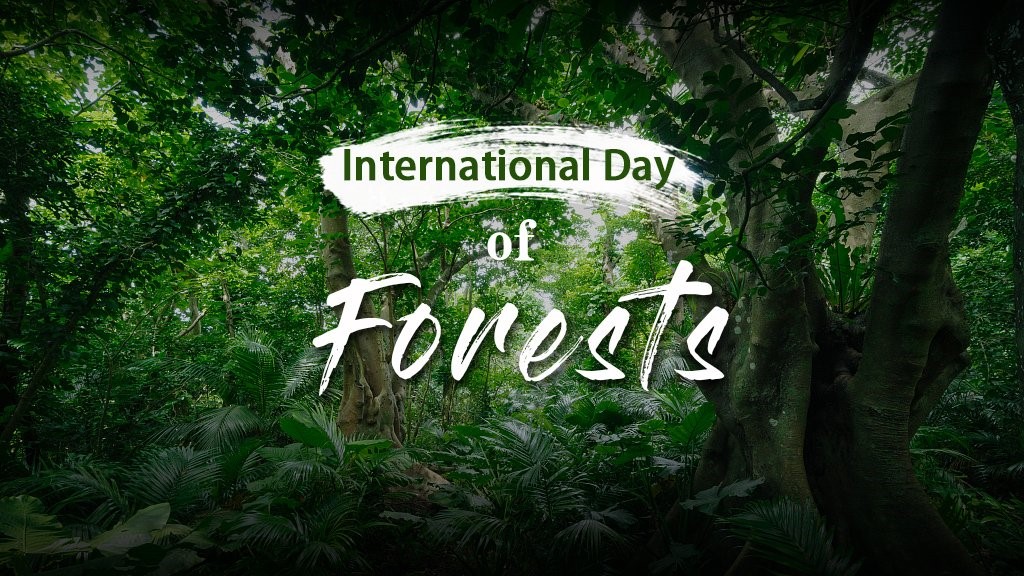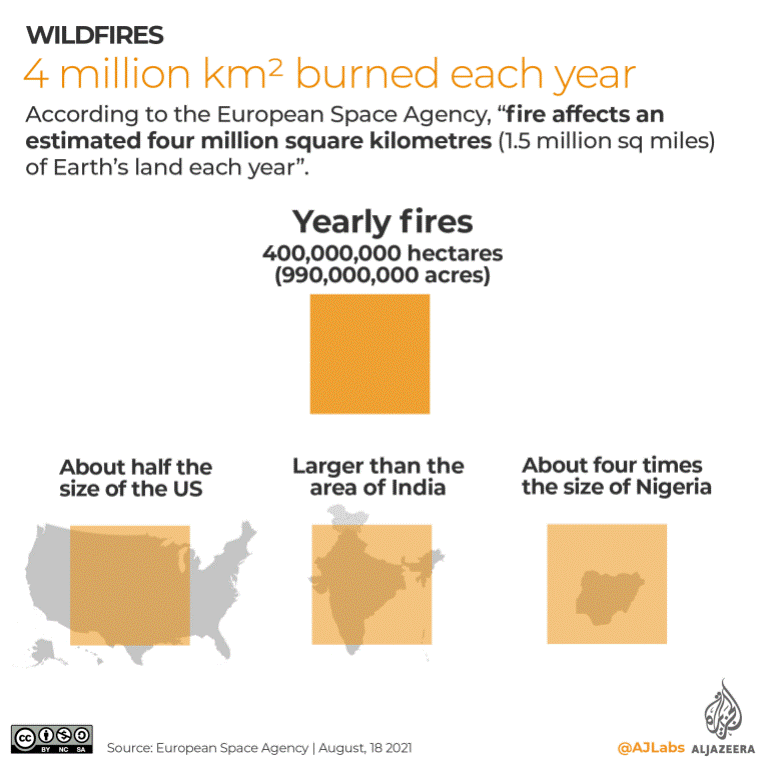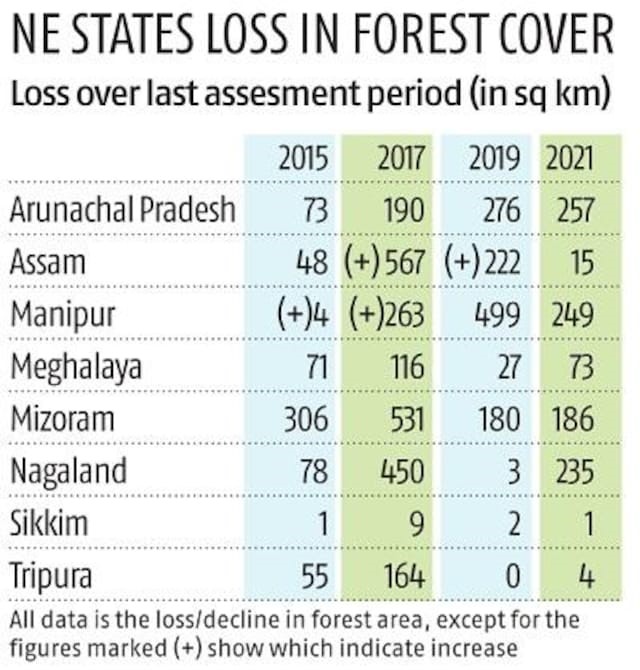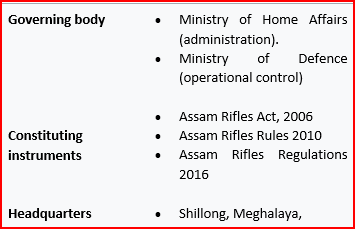INTERNATIONAL DAY OF FORESTS

Disclaimer: Copyright infringement not intended.
Context
- Every year, the International Day of Forests is celebrated on 21st
International Day of Forests
- The International Day of Forests was established on the 21st day of March, by resolution of the United Nations General Assembly on November 28, 2013.
- Each year, various events celebrate and raise awareness of the importance of all types of forests, and trees outside forests, for the benefit of current and future generations.
2023 Theme
- The 2023 International Forests Day theme is Forests and Health.
- While it emphasizes forest-led services for health and well-being, it re-emphasizes the role of forests in mitigating climate risks, purifying our air, and sequestering carbon, among others.
Forest and its importance
- Forests cover 31% of the land area on our planet.
- They help people thrive and survive by, for example, purifying water and air and providing people with jobs; some 13.2 million people across the world have a job in the forest sector and another 41 million have a job that is related to the sector.
- Many animals also rely on forests. Forests are home to more than three-quarters of the world’s life on land.
- Forests also play a critical role in mitigating climate change because they act as a carbon sink—soaking up carbon dioxide that would otherwise be free in the atmosphere and contributing to ongoing changes in climate patterns.
State of Forests (World)
Forests shrinking: FAO Report
- The FAO’s latest report on State of the World’s Forests (2022) states that forests cover 31% of the Earth’s land surface but the area is shrinking, with 420 million ha of forests lost due to deforestation between 1990 and 2020.
Deforestation
- Between 2015 and 2020, the rate of deforestation was estimated at 10 million hectares per year.
- The main cause of deforestation is agriculture (poorly planned infrastructure is emerging as a big threat too) and the main cause of forest degradation is illegal logging.
- Deforestation is a particular concern in tropical rainforests because these forests are home to much of the world’s biodiversity. For example, in the Amazon around 17% of the forest has been lost in the last 50 years, mostly due to forest conversion for cattle ranching.
- Deforestation in this region is particularly rampant near more populated areas, roads and rivers, but even remote areas have been encroached upon when valuable mahogany, gold, and oil are discovered.
Wildfires
- According to the European Space Agency, “fire affects an estimated four million square kilometres of Earth’s land each year”.

- Climate change, changes in land-use, and land management practices are responsible for the increasing risks of wildfires.
- UNEP report projected that the number of wildfires is likely to increase by up to 14 per cent by 2030. It is projected to spike by 33 percent by 2050. It would rise by 52 percent by 2100.
State of Forests in India
ISFR Report
- According to 2021, Forest Survey report the total forest and tree cover of the country is 9 million hectare which is 24.62 percent of the geographical area of the country.
- The land under forest area has grown by just 1,540 sq km over 2019, according to the Forest Survey of India’s biennial India State of Forest Report (ISFR), 2021.
Concerns
Slowed Forest Cover Growth
- India’s forest cover growth has slowed to an eight-year low in 2021, with just 0.22 percent increase over 2019, down from 0.85 per cent in 2013 and 0.94 percent in 2017, the highest in the last decade.
Slowed Tree Cover
- Similarly, the growth in tree cover is 0.76 percent in 2021 over 2019, the lowest rate since 2015. As of 2021, the total forest and tree cover comprises 24.62 percent of the geographical area of the country.
Highest Forest reduction in North-East
- The highest amount of forest cover reduction is happening in the Northeast (N-E) states, which host some of the world’s richest and unique biodiversity. Nagaland has the country’s highest reduction of forest cover of 1.88 per cent since 2019.
- The loss of forest cover in the N-E states has intensified in the last decade. The worst of all is Mizoram, which has shown no increase in the past decade and is showing a fast decline in the forest cover.

Rise in Forest Fires
- Between November 2020 and June 2021 period, 345,000 incidents of forest fire were detected by FSI sensors, a 177 per cent increase over incidents detected during November 2019-June 2020.
Way Ahead
- Halting deforestation and maintaining forests.
- Restoring degraded lands and expanding agroforestry.
- Sustainably using forests and building Green Value Chains.
- India should recognize forest fire as a disaster type under the National Disaster Management Authority (NDMA) Act, 2005. Doing so will act as a catalyst for creating specialized teams of trained forest firefighters under the National and State Disaster Response Forces.
- There is an urgent need to revitalize and re-conserve forests, which can not only generate employment opportunities for tribal and forest-dwelling communities but also mitigate climate risks and promote ecological sustainability.
- India has a rich heritage of ayurvedic medicine. Developing an Integrated Forest Surveillance System (IFSS) jointly by the nodal ministries- the Ministry of Environment, Forest and Climate Change and the Ministry of Ayush should become to identify and map critical forest vulnerabilities that can stand to the litmus test of climate change and abused landscape degradation. This would enable the integration of medicinal plants into forest restoration sites, particularly in regions with heightened climate vulnerability.
- A climate-biodiversity-nexus urban forest development strategy should become a national imperative to promote a sustainable and resilient future for India's cities. To promote climate-biodiversity-nexus urban forest development, it is important to promote nature-based solutions that can promote faster and better urban forests with flora that can mitigate climate risks and clean the air. Cities like Singapore, Melbourne, and New York have successfully implemented such strategies, with programs such as Singapore's City in a Garden initiative and New York's Million Trees NYC project.
- Cities can encourage community engagement and involve citizens in tree-planting activities and other green initiatives to foster a sense of ownership and stewardship towards urban forests.
Closing Remarks
- India can pave a sustainable developmental pathway that climate-protects the lives and livelihoods of millions while preserving our precious natural heritage by managing forests better to ensure health and well-being.
https://newsonair.gov.in/Spotlight.aspx#
.jpeg)
CRPF
Context
- Union Minister for Home Affairs and Cooperation Amit Shah attended the 84th CRPF Day parade ceremony.
Details
- About: The Central Reserve Police Force (CRPF) is a federal police organisation in India under the authority of the Ministry of Home Affairs (MHA).
- Primary Role: The CRPF's primary role lies in assisting the State/Union Territories in police operations to maintain law and order and counter-insurgency.
- Composition: It is composed of Central Reserve Police Force (Regular) and Central Reserve Police Force (Auxiliary).
- Establishment: It came into existence as the Crown Representative's Police on 27 July 1939.
- Post-Independence scenario: After Indian independence, it became the Central Reserve Police Force on enactment of the CRPF Act on 28 December 1949.
- Mission: The mission of the Central Reserve Police Force shall be to enable the government to maintain Rule of Law, Public Order and Internal Security effectively and efficiently to preserve National Integrity & Promote Social Harmony and Development by upholding supremacy of the Constitution.
- Largest Central Armed Police Force: With 246 battalions and various other establishments, the CRPF is considered India's largest central armed police force and has a sanctioned strength of more than 300,000 personnel as of 2019.
https://newsonair.gov.in/News?title=HM-Amit-Shah-to-attend-84th-CRPF-Day-parade-ceremony-in-Chhattisgarh-on-March-25&id=458133
ASSAM RIFLES
Context
- Defence Minister Rajnath Singh has extended greetings to the Assam Rifles personnel and their families on their Raising Day.
All about Assam Rifles
- The Assam Rifles(AR) is a central paramilitary force responsible for border security, counter-insurgency, and maintaining law and order in Northeast India. It guards the Indo-Myanmar border.
- The AR is one among the Central Armed Police Forces(CAPF) and comes under the administration of the Ministry of Home Affairs, while its operational control is maintained by the Indian Army.
- Being a police force, its recruitment, perks, promotions, and retirement policies are governed by CAPF rules.
- Around 80 percent of its officers are deputed from the Indian Army and remaining from AR cadre.
- The AR is commanded by the Director General of the Assam Rifles who is appointed by the Ministry of Home Affairs.
- The AR is also dubbed as "Sentinels of the North East" and "Friends of the Hill People". It is the oldest paramilitary force in India, originally raised in 1835 as Cachar Levy, a militia to protect tea gardens and fertile plains of Assam against unruly tribes.
- It got its present name in 1917. After independence, the AR functioned under the Ministry of External Affairs.
- Its operational control was transferred to the Indian Army post Sino-Indian War of 1962.
- It came under the administration of Ministry of Home Affairs in 1965, with Army retaining operational control.
- The Assam Rifles have served in a number of roles, conflicts and theatres including World War I, they served in Europe and the Middle East, and World War II, where they served mainly in Burma. After the Chinese annexation of Tibet, the Assam Rifles were tasked with manning the Tibetan border of Assam Himalayan region. They were also instrumental in maintaining law and order in Arunachal Pradesh.
- In times of war they can also be used as a combat force to secure rear areas if needed. Since 2002, the force has been given the role of guarding the India–Myanmar border.

https://newsonair.gov.in/News?title=Defence-Minister-Rajnath-Singh-extended-greetings-to-Assam-Rifles-personnel-on-Raising-Day&id=458126

NATIONAL INSTITUTE OF URBAN AFFAIRS
Context
- The first Urban Climate Film Festival under U20 engagement events is being organised by the National Institute of Urban Affairs.
Details
- A curated selection of 11 films from nine countries will be showcased in the festival to create wider awareness of the impact of climate change on life in cities. The festival is being organised with support from the Ministry of Housing and Urban Affairs, the French Development Agency and the European Union.
About NIUA
- The National Institute of Urban Affairs(NIUA) is an institute for research, training and information dissemination in urban development and management in New Delhi.
- It was established in 1976 as an autonomous body under the Societies Registration Act.
- The Institute is supported by the Ministry of Urban Development, Government of India, State Governments, urban and regional development authorities and other agencies concerned with urban issues.
- NIUA conducts research on urbanization, urban policy and planning, municipal finance and governance, land economics, transit oriented development, urban livelihoods, environment & climate change and smart cities.
https://newsonair.gov.in/News?title=NIUA-organises-first-Urban-Climate-Film-Festival-under-U20-engagement-events&id=458127

SECTION 8(3) OF THE RPA ACT
Context
- Congress leader Rahul Gandhi has been disqualified from the membership of Lok Sabha following his conviction by a Gujarat court in a defamation case filed against him.
Why has Rahul Gandhi been convicted?
- The case pertains to Gandhi's 'controversial' speech delivered in Kolar during the 2019 political campaign, wherein he had linked Prime Minister Narendra Modi with fugitives like Nirav Modi and Lalit Modi. He had said,
"Nirav Modi, Lalit Modi, Narendra Modi. How come all the thieves have 'Modi' as a common surname?"
- Purnesh Modi, a former BJP Member of Legislative Assembly (MLA) took exception to the said speech claiming that Gandhi humiliated and defamed all persons with the Modi surname.
- The court agreed with that and held that Rahul Gandhi had insulted all persons with the surname 'Modi'.
- The Court observed that since Gandhi is a Member of Parliament (MP), whatever he says will have a greater impact. Thus, he should have exercised restraint.
What sentence was imposed?
- Gandhi was convicted under Sections 499 and 500 of the Indian Penal Code (IPC), the maximum sentence for which is two years and/or fine.
- The court, however, granted him bail and suspended the sentence for 30 days to allow him to appeal before a higher court.
He stands disqualified from the membership of the Lok Sabha from the date of his conviction i.e. 23 March, 2023 in terms of the provisions of Article 102 (1)(e) of the Constitution of India read with Section 8 of the Representation of People Act,1951.”
What is Article 102 of the Indian Constitution?
- Article 102 deals with the disqualification of MPs from either house of the Parliament.
- Part (1) of the article lists the reasons why an MP can be disqualified. These include,
(a) if he holds any office of profit under the Government of India or the Government of any State, other than an office declared by Parliament by law not to disqualify its holder;
(b) if he is of unsound mind and stands so declared by a competent court;
(c) if he is an undischarged insolvent;
(d) if he is not a citizen of India, or has voluntarily acquired the citizenship of a foreign State, or is under any acknowledgment of allegiance or adherence to a foreign State;
(e) if he is so disqualified by or under any law made by Parliament.”
In Rahul Gandhi’s case, the last point (if he is so disqualified by or under any law made by Parliament) applies. The law under which he has been disqualified is the Representation of People Act, 1951.
What is the Representation of People Act, 1951?
- The Representation of the People Act, 1951 is an act of Parliament of India to provide for the conduct of election of the Houses of Parliament and to the House or Houses of the Legislature of each State, the qualifications and disqualifications for membership of those Houses, the corrupt practices and other offences at or in connection with such elections and the decision of doubts and disputes arising out of or in connection with such elections.
- It was introduced in Parliament by law minister Dr BR Ambedkar.
Sections
Section 8(1)
- First, disqualification is triggered for conviction under certain offences listed in Section 8(1) of The Representation of The People Act. This includes specific offences such as promoting enmity between two groups, bribery, and undue influence or personation at an election.
Section 8(2)
- It lists offences that deal with hoarding or profiteering, adulteration of food or drugs and for conviction and sentence of at least six months for an offence under any provisions of the Dowry Prohibition Act.
Section 8(3)
- It states: “A person convicted of any offence and sentenced to imprisonment for not less than two years shall be disqualified from the date of such conviction and shall continue to be disqualified for a further period of six years since his release.” This is the provision under which Rahul Gandhi has been disqualified.
What are the Supreme Court judgments holding the field?
- In Lily Thomas v. Union of India(2013), the Supreme Court strengthened the parameters of qualification by declaring Section 8(4) of Representation of People Act, 1951 as ultra vires the Constitution.
- The top court in Lily Thomas held that any legislator/parliamentarian convicted of a crime and awarded a minimum of two years imprisonment loses membership of the house with immediate effect.
Can the disqualification be set aside?
- The only way Gandhi's disqualification from the Lok Sabha can be overturned is if a higher court stays the conviction by the Surat court.
- Significantly, the stay cannot merely be a suspension of sentence under Section 389 of the Code of Criminal Procedure (CrPC), but a stay of conviction.
- In its 2018 judgment in Lok Prahari v. Union of India, the Court had held that upon a stay of a conviction under Section 389 of the Code of Criminal Procedure (CrPC), the disqualification under Section 8 will not operate.
|
DO YOU KNOW?
Under the RPA, Section 8(4) stated that the disqualification takes effect only “after three months have elapsed” from the date of conviction. Within that period, lawmakers could file an appeal against the sentence before the High Court.
However, in the landmark 2013 ruling in ‘Lily Thomas v Union of India’, the Supreme Court struck down Section 8(4) of the RPA as unconstitutional. This is what has allowed the Lok Sabha Secretariat to immediately disqualify Rahul Gandhi.
|

https://newsonair.gov.in/News?title=Congress-leader-Rahul-Gandhi-disqualified-from-Lok-Sabha-after-conviction-in-criminal-defamation-case&id=458130







